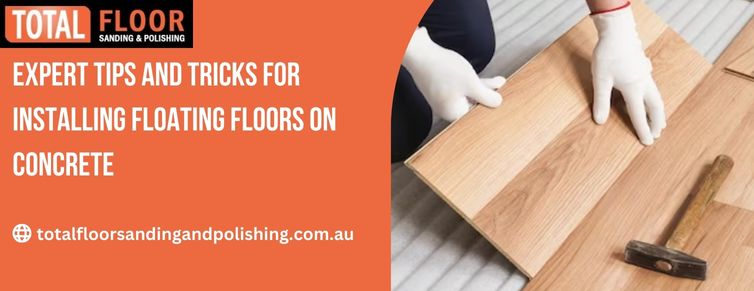Oh no! Those tired, outdated floors that seem to drag down the entire aesthetic of your home—sound familiar? If you’re ready to bid farewell to the worn-out and welcome in the wow factor, you’re in the right place!
We get it, the thought of revamping your floors, especially for floating floor installation on concrete, might sound like a daunting task. But fear not!
In this blog, we’ve compiled a treasure trove of expert tips and tricks to make installing floating floors on concrete a breeze. From choosing the right materials to mastering the floor installation Melbourne process, we’ve got you covered.
Let’s dive in and transform your space!
Assessing the Concrete Subfloor
Before beginning the installation, it is crucial to assess the condition of the concrete subfloor. This step helps identify potential issues and ensures a solid foundation for the floating floor. Factors to consider include moisture levels, cracks, and unevenness. By addressing these issues beforehand, you can prevent future problems and ensure the longevity of your flooring.
Moisture Testing and Mitigation
Moisture testing is paramount when installing floating floors on concrete. Excessive moisture can damage the flooring materials and compromise the integrity of the installation. There are different methods of moisture testing, such as the calcium chloride test or the relative humidity test.
These tests provide valuable information on the moisture levels in the concrete. If excessive moisture is detected, mitigation measures such as using a vapour barrier or applying a moisture barrier coating should be taken to protect the flooring.
Acclimating Flooring Materials
Properly acclimating the flooring materials to the environment where they will be installed is essential. Temperature and humidity can significantly impact the performance of floating floors.
It is recommended to acclimate the materials in the room where they will be installed for at least 48-72 hours. This allows the materials to adjust to the temperature and moisture levels, reducing the risk of expansion or contraction after installation.
Underlayment Selection and Installation
Underlayment plays a crucial role in floating floor installations on concrete. It provides additional support, sound insulation, and moisture protection. There are various types of underlayment available, including foam, cork, and rubber. Each type offers specific benefits, so it’s important to choose the one that suits your needs. Proper installation of the underlayment is also essential to ensure a smooth and stable surface for the flooring.
Selecting the Right Tools and Materials
To ensure a successful floating floor installation on concrete, it is important to have the right tools and high-quality materials. Essential tools for installing floating floors on concrete include a circular saw, moisture meter, tapping block, and pull bar, among others.
Additionally, investing in specific tools like a floor installation kit can make the process easier and more efficient. When selecting flooring materials, opt for products that are specifically designed for concrete subfloors to ensure compatibility and durability.
Installation Techniques for Floating Floors on Concrete:
There are several installation methods for floating floors on concrete, depending on the type of flooring materials chosen. The most common methods are the click-lock system and the glue-down method. If applicable, the nail-down method can also be used. Let’s explore each technique in detail:
Floating Floor Click-Lock System Installation:
The click-lock system is a popular choice for floating floor installation Melbourne due to its ease of use and stability. With this method, the flooring planks simply click together, creating a tight and secure connection. To install using the click-lock system on concrete, follow these steps:
1. Prepare the subfloor by ensuring it is clean, dry, and level.
2. Install the underlayment according to the manufacturer’s instructions.
3. Begin the installation in a corner of the room, with the tongue side facing the wall.
4. Insert the tongue of the first plank into the groove of the previously installed plank at a slight angle.
5. Gently tap the plank into place using a tapping block and mallet.
6. Continue the installation, ensuring each plank is securely locked with the previous one.
7. Use a pull bar and hammer to close gaps along the walls.
8. Trim the last row of planks to fit, leaving an expansion gap.
9. Install baseboards or quarter-round moulding to cover the expansion gap.
Throughout the installation, it is important to maintain proper expansion gaps and ensure the planks are aligned and level.
Glue-Down Installation Method
The glue-down method is an alternative option for installing floating floors on concrete. It provides added stability and can be used with various types of flooring materials. Here are the steps to follow for a successful glue-down installation:
1. Prepare the subfloor by cleaning it thoroughly and removing any debris.
2. Apply a moisture barrier coating if necessary.
3. Spread the adhesive evenly on the concrete subfloor, following the manufacturer’s instructions.
4. Install the first row of flooring planks, leaving an expansion gap along the walls.
5. Apply adhesive to the tongue and groove of each plank before connecting them.
6. Press each plank firmly into place, ensuring a tight bond with the adhesive.
7. Use a tapping block and a mallet to secure the planks together.
8. Continue the installation, row by row, following the manufacturer’s recommendations.
9. Trim the last row of planks to fit, leaving an expansion gap.
10. Allow the adhesive to cure according to the manufacturer’s instructions before walking on the floor or installing baseboards
Nail-Down Installation Method (if applicable)
In some cases, the nail-down method may be suitable for installing floating floors on concrete. This method typically requires a plywood subfloor to nail the flooring planks securely. If your project allows for a plywood subfloor, follow these steps:
1. Install a plywood subfloor over the concrete, following the appropriate guidelines.
2. Begin the installation in a corner of the room, with the groove side facing the wall.
3. Place the first plank against the wall, leaving an expansion gap.
4. Use a nailer or hammer and nails to secure the plank to the plywood subfloor.
5. Continue the installation, ensuring each plank is securely nailed down.
6. Trim the last row of planks to fit, leaving an expansion gap.
7. Install baseboards or quarter-round moulding to cover the expansion gap.
Step-by-Step Floating Floor Installation Guide
To provide a comprehensive guide for installing floating floors on concrete, let’s break down the process into step-by-step instructions:
1. Assess the condition of the concrete subfloor, checking for moisture, cracks, and unevenness.
2. Perform moisture testing using the appropriate method (calcium chloride test or relative humidity test).
3. Mitigate excessive moisture if detected by using a vapour barrier or moisture barrier coating.
4. Acclimate the flooring materials in the installation environment for 48-72 hours.
5. Install the chosen underlayment according to the manufacturer’s instructions.
6. Select the right tools and materials for the installation, ensuring compatibility with concrete subfloors.
7. Choose the appropriate installation method (click-lock system, glue-down, or nail-down) based on the flooring materials.
8. Follow the step-by-step instructions for the chosen installation method, ensuring proper alignment, levelling, and expansion gaps.
9. Trim the last row of planks to fit and install baseboards or quarter-round moulding to cover the expansion gap.
10. Clean the installed floor and enjoy your beautiful, durable floating floor on concrete.
Throughout the floor installation Melbourne process, refer to the manufacturer’s instructions for specific guidance and recommendations.
Managing Challenges and Problem Solving
While installing floating floors on concrete, you may encounter challenges or issues that require troubleshooting. Here are some common challenges and practical solutions:
– Uneven subfloor: Level the subfloor using self-leveling compound or plywood underlayment before installing the flooring.
– Damaged flooring planks: Replace damaged planks with new ones, ensuring a seamless transition.
– Gaps between planks: Use wood filler or color-matched caulk to fill small gaps and create a uniform appearance.
– Subfloor moisture: If moisture levels are consistently high, consider professional help to address the underlying issue.
If you encounter any other challenges, don’t hesitate to consult with a professional floor installation Melbourne company or seek guidance from reliable sources.
When to Hire Professional Installation Services
While DIY installations are possible, there are situations where hiring professional installation services is beneficial or necessary. These include:
– Complex installations: If your project involves intricate patterns, multiple rooms, or unique design elements, professionals can ensure precise and flawless results.
– Specialised requirements: Certain flooring materials, such as exotic hardwood or high-end luxury vinyl, may require specific expertise for proper installation.
– Time constraints: If you have a tight schedule or limited time for the installation, professionals can expedite the process without compromising quality.
– Lack of experience or confidence: If you are unsure about your abilities or lack experience in installing floating floors on concrete, professional floor installation Melbourne service can provide peace of mind and ensure excellent results.
Conclusion:
Installing floating floors on concrete can be a rewarding project that enhances the beauty and functionality of your space. By following the expert tips and tricks provided in this blog post, you can tackle the installation process with confidence.
Remember to assess the concrete subfloor, perform moisture testing, acclimate the flooring materials, choose the right tools and materials, and follow the appropriate installation techniques.
In case of any challenges, refer to the troubleshooting advice or consider hiring professional floor installation Melbourne services.
At Total Floor Sanding and Polishing, we specialise in delivering professional floor installation services. With a commitment to excellence, our skilled team ensures meticulous assessments of concrete subfloors, precise moisture testing, and the use of top-notch tools and materials.
Count on us to transform your space with expertise and finesse.


